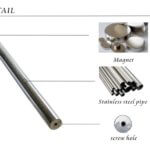What are Alnico Magnets?
Alnico magnets are permanent magnets fabricated from aluminum, nickel, and cobalt. They are available in isotropic, non-directional, or anisotropic, mono-directional form. Once magnetized, they have 5 to 17 times the magnetic attraction of magnetite or lodestone magnets.
Alnico magnets have a high-temperature coefficient and can be calibrated for prime residual induction to be used in applications with temperatures up to 930°F or 500°C. They’re used where corrosion resistance is critical and for sensors.
Shapes and kinds of Alnico Magnets
Alnico magnets are available in a wide variety of shapes and sizes to fit several applications. They can be found in:
- Small toys
- Electric guitars
- In factories
- Industrial applications
The shapes of alnico magnets are produced by sintering or casting with casting being the most common method.
Cylinder:
Cylinder, or rod, magnets are used for seals, sensors, coin collection machines, and guitar pickups.
The concentration of alnico magnets makes them ideal for use in amplifiers, actuators, and motors. Cylinder alnico magnets are used for medical applications due to their strength and ability to be adjusted.
Pot:
Pot, holding, or mounting alnico magnets are used for holding applications and are an alternative to fixture and fastening methods. As mounting magnets, they can be easily removed, unlike permanent fasteners.
Bar:
Bar or block magnets are used in schools for learning activities, like demonstrating a flux. They are the weakest shape due to the little area of the poles but are the most common shape and are used in automation, separation, and holding applications.
Ring:
Ring alnico magnets are circular with a hole in the middle and are sometimes referred to as donut magnets. The placement of their north and south poles depends on how they are polarized. One-half the magnet is the north pole, while the opposite half is the south. They can also be polarized into quarters or eighths.
Ring magnets are used for science experiments and medical applications for people with implanted cardioverter defibrillators, or ICDs, which automatically gives a shock to a patient’s heart when its rhythm becomes irregular. When the ICD malfunctions, it gives a shock to the patient unnecessarily, which results in an irregular rhythm. Placing a ring magnet in a patients’ chest, over the ICD, disables the device when the rhythm is irregular.
Horseshoe:
Horseshoe magnets are bar magnets that are formed into the shape of a U, which makes them stronger because the poles are pointed in the same direction. They can lift metal objects of any size depending on the strength of the magnet.
Alnico Magnet Coatings
Alnico magnets are highly resistant to oxidation and corrosion and do not need a protective coating, plating, or surface protection. They are unaffected by exposure to grease, solvents, gasoline, or alcohol.
Their vulnerability alnico magnets is their iron content. When exposed to water for an extended period of time, they develop surface corrosion. This same weakness can occur if they’re exposed to alkali solutions and inorganic acids.
Though a coating isn’t needed, manufacturers will paint alnico magnets to improve their appearance and hide their natural dark grey color. In the majority of cases, red is the color of choice, but they can be coated with chrome or nickel.
Grades of Alnico Magnets
Alnico magnets are available in several variations with different amounts of aluminum, nickel, and cobalt. The varying percentage of the base metals alters the strength of the magnet, which creates a variation in the magnetic field.
There are 29 grades of alnico magnets with 17 being cast, 10 sintered, and a couple bonded. The grading system is predicated on the magnet’s chemical composition, residual induction, coercive force, maximum energy, the percent of cobalt, and operating temperature. As the operating temperature rises, so does the grade of the magnet.
The majority of alnico magnets are anisotropic, which have the highest power. Below could be a discussion of a view of the alnico grades and their use.
Uses of Alnico Magnets
Alnico magnets are used for applications with high operating temperatures and where a robust static magnet is required, such as electric motors, guitar pickups, microphones, sensors, loudspeakers, and cow magnets.
The high density, magnetic force, and affordable price of alnico magnets makes them the first choice for several applications. They have the lowest temperature coefficient of any form of the magnet at 0.02% per degree of centigrade, which creates temperature stability.


